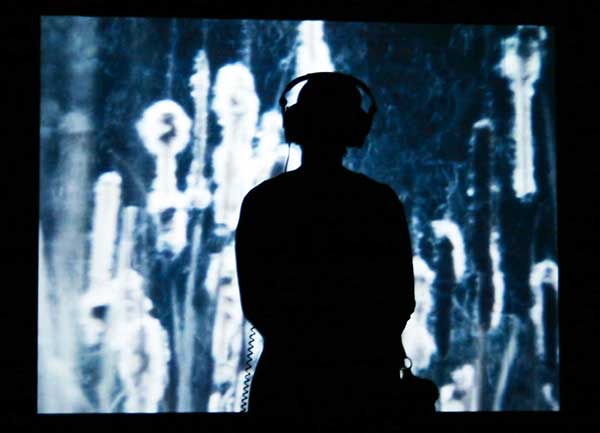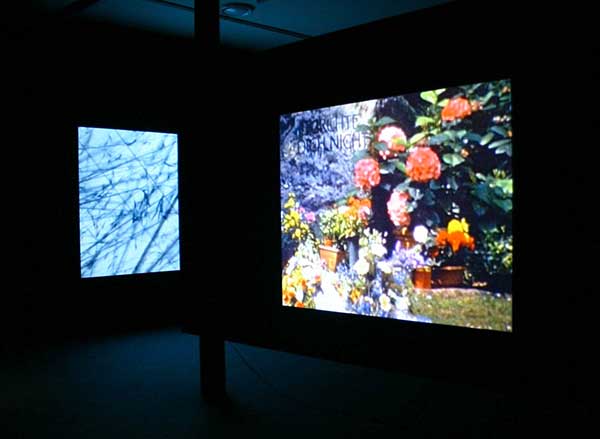|
Mise-en-phónics
by
Jake Wilson
This
article was originally published in the Discreet Montage catalogue.
ANYONE WHO HAS SEEN more than a few experimental films will know that the challenge of fruitfully combining sound and image is a tough one. An emotionally coded soundtrack can define a film’s mood all too insistently, flattening out visual discrepancies and fluctuations; worse still, the sound can mimic these fluctuations in a slavish, over-literal manner.
In their joint work across the last couple of decades, Barry Brown and Irene Proebsting fall into neither trap. True, Brown’s soundscapes “set the tone” for Proebsting’s Super-8 footage, often hinting at undercurrents that might not otherwise be so apparent—as in Mayana (1995-6), where outwardly innocent home movie footage is given an unnerving accompaniment of whooshes and bleeps. But rather than fixing the relationship between sound and image, the films maintain a productive tension between the two, allowing each to change course without reference to the other.
At the same time, these long-term collaborators stay close to each other in spirit. Brown’s soundscapes veer between music as conventionally understood and assemblages incorporating “found” noises: the hum of an electrical current, a clatter like knives falling onto a cement floor. Likewise, Proebsting’s images hover between abstraction and representation, typically making use of simple “in camera” effects: fast cuts, blurry flash pans, shots deliberately out of focus or over-exposed.

Installation view 1
At the end of Abandoned Empire (2012), Brown credits Proebsting with camerawork and also “mise-en-phónics”, a striking term I haven’t encountered elsewhere. This could imply that she fits her images to Brown’s sounds—or that the images themselves are sound by other means, intended not to delineate concrete spaces and events, but to evoke an ambience through rhythm, tonality, vibration. In doing so, they appear to point to something further which we can’t see, generating an uneasy mood mingling anxiety over buried trauma with mourning for whatever is gone even from memory.
In short, these are films constructed around absences, a tendency linked to Brown and Proebsting’s fondness for what the writer Marcus Clarke famously called the “weird melancholy” of the Australian landscape. The elegiac Field (1997) largely restricts itself to variations on a few types of imagery, in muted shades of blue, grey and brown: dried-up grass, slender criss-crossed branches suggesting Japanese calligraphy, gnarled trees reflected in rippling bodies of water. In sympathy with this limited palette, Brown’s plaintive guitars rely on a handful of notes and phrases, with a recurring upward major seventh—almost but not quite an octave—suggesting a leap that just falls short.
This subdued, mournful lyricism is characteristic of Brown and Proebsting, but they’re also capable of moments of Australian Gothic shading into horror—as in Postlude (2013), where a dog wanders through the scorched-earth aftermath of a bushfire, or Mayana, where a high-pitched electronic tone accompanies a zoom out from the carcass of a slaughtered kangaroo. Dwelling on the rusting towers of a disused industrial plant, Abandoned Empire leaves itself open to interpretation—are the filmmakers lamenting the economic decline of regional Australia, or commenting wryly on the hubris that produced such doomed monuments in the first place? With present-day humanity nowhere in evidence, the question is left for the viewer to answer, though the clanging and banging supplied by Brown suggests that labour continues to be performed by a workforce of ghosts.

Installation view 2
As all of these instances suggest, the losses commemorated in this work are equally environmental, social and personal. Shifting from one register to another, the films thwart our desire for explanations and summaries in a way that maintains an essential privacy, but can also be teasing, even playful. The black-and-white Harmonic Ghosts (2009) begins in almost total abstraction, with blobs of white light pulsing against a dark background; the soundtrack consists of a single sustained, rumbling tone, as if a gong, struck once, were to vibrate at the same volume indefinitely. After half a minute or so, the blobs give way to a rush of fragmentary but legible images: flashes of ferns and branches, a church spire, another wandering dog.
Further close-up images of Australian flora are intercut with glimpses of a small group of people coming together, heads bowed, soberly dressed: could we be looking at the preliminaries to a funeral? The film’s final seconds appear to confirm the hypothesis, pinning down the film’s meaning up to a point: a close-up shows a placard with a half-visible inscription, the central words reading “LOVE YOU DAD”. A slightly blurred wide shot centres on what is presumably this same placard, attached to a plain white cross in the middle of a field; briefly the camera is turned on its side, before it swivels upright. Around the grave is a field of long, dry grass, stretching almost to the horizon, waving in the wind. On the soundtrack, the rumbling tone persists, fading as these scattered images run out.
JAKE WILSON is a film reviewer for Fairfax Media and the author of Mad Dog Morgan (2015).
Discreet Montage had an extended screening from July 22 to December 11 at Latrobe Regional Gallery, 2016.
©
Jake Wilson, 2016.
Back
to Barry Brown profile
Back
to Irene Proebsting profile |